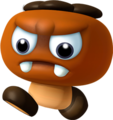Goombrat
Template:Species-infobox Goombrats[1][2] are a species of Goomba that debuted in the Wii U title New Super Mario Bros. U. They are short, are lighter brown, and resemble persimmons more than mushrooms. They have wider eyes in a scowl instead of eyebrows, and the black stems on their head are similar to tomato leaves. They also turn when they reach edges, which is similar to the behavior of red Koopa Troopas. The enemy's name is a composition of "Goomba" and "brat". Additionally, their teeth point down and have a curved shape, while regular Goombas' teeth point up and are sharp. The teeth look similar to how Goomba teeth do in Super Mario Bros. 3.
These sub-species only appear in the sky level of Acorn Plains, Mushroom Heights, and one of the levels in Challenge Mode, The Goombrat Stomp.
In New Super Luigi U they are significantly more common.
Goombrats reappear Mario Party 10, seen in some minigames alongside Goombas and Galoombas. They also appear in Mario Party: Star Rush.
Goombrats appear in the version 3.0.4 update in Super Mario Run, where they appear in the levels Scuttlebug Forest and Spike Bar Jungle. In Scuttlebug Forest, one can be seen with a Super Mushroom on its head. A few other Goombrats glow in a yellow tone, and stomping them will release more coins than usual. A large variety also appears in some special remix courses in the Remix 10 mode.
Profiles and statistics
Mario Party: Star Rush
| Image | Name | Bio |
|---|---|---|

|
Goombrat An enemy that looks like a persimmon |
"Goombrats are fated to forever walk to the edges of platforms only to turn around and walk right back. Poetic?" |
Super Mario Run
- Notebook bio: "This enemy enjoys going for strolls in the forest. Vault over it, or just give it a good ol' stomp!"
Names in other languages
| Language | Name | Meaning |
|---|---|---|
| Japanese | カキボー[3] Kakibō |
Persimmon people |
| Dutch | Goombrat |
- |
| German | Gumbalg |
|
| Italian | Goombarello |
Possibly "Little Goomba" |
| Korean | 감바 Gamba |
From 굼바 Gumba and 감 gam, which means persimmon |
| Portuguese (NOA) | Goombinha |
"Goomba" with the diminutive suffix -inha |
| Portuguese (NOE) | Goombito |
"Goomba" with the diminutive suffix -ito |
| Russian | Гумбака Gumbaka |
From гумба gumba and the diminutive suffix -ка -ka |
| Spanish (NOA) | Goombiño |
Conjunction of "Goomba" and niño (boy) |
| Spanish (NOE) | Goombrat |
- |
Gallery
New Super Mario Bros. U model
Mario Party 10 artwork
Group of Goombrats in Mario Party: Star Rush
References
- ^ New Super Mario Bros. U Prima eGuide, Enemies Tab.
- ^ The Goombrat Stomp
- ^ New Super Mario Bros. U official Dengeki Kouryaku Japanese guide, page 12


